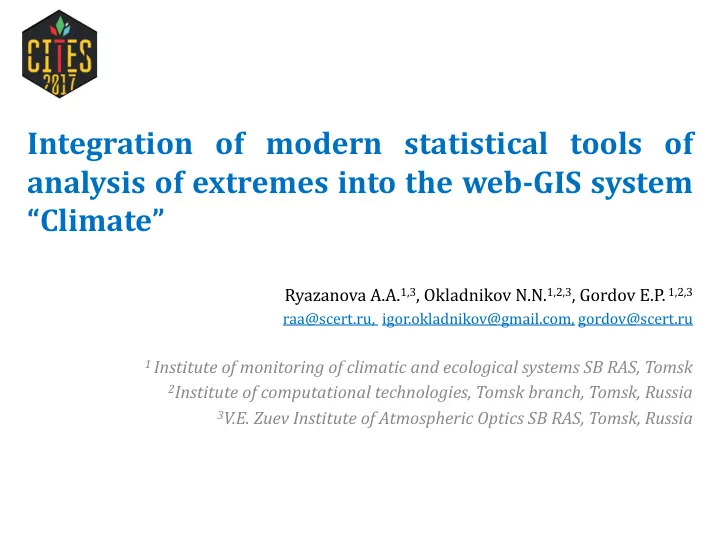

Integration of modern statistical tools of analysis of extremes into the web-GIS system “Climate” Ryazanova A.A. 1,3 , Okladnikov N.N. 1,2,3 , Gordov E.P. 1,2,3 raa@scert.ru, igor.okladnikov@gmail.com, gordov@scert.ru 1 Institute of monitoring of climatic and ecological systems SB RAS, Tomsk 2 Institute of computational technologies, Tomsk branch, Tomsk, Russia 3 V.E. Zuev Institute of Atmospheric Optics SB RAS, Tomsk, Russia
Introduction The second part of 1970s is characterized by the beginning of modern global climate change. Heavy precipitation and strong storms , droughts and heat wave show positive trends in several regions of the world. We need to better understand their impact on the environment and also be able to predict them and minimize their consequences . 2
Web-GIS system “Climate” • is based on a combined use of web and GIS technologies; • is a part of a hardware and software complex for “cloud” data analysis using: – various climatic data sets; – dedicated algorithms for their searching, extraction, processing, and visualization. • significantly facilitates and accelerates analysis of big volumes of geospatial data. System “Climate” allows researchers to perform complex climate data analysis using desktop PCs with internet connection. 3
Web-GIS system “Climate”: existing opportunities The system already has a large number of computational modules calculating: • standard statistical characteristics of meteorological values; • extreme indices recommended by the WMO ETCCDI; • hydrothermal coefficients. 4
Web-GIS system “Climate”: new opportunities We have integrated into our system the special additional statistical packages of program language R that allow to use new more powerful methods of analysis: • time-dependent statistics of extremes; • quantile regression; • copula approach. 5
Conclusion Integration of new opportunities allows us: • to do more detailed analysis of different extremes; • to determine the degree of their impacts; • to obtain structural links between these extremes and different characteristics of the environment. 6
Illustration of successful integration Input data: ERA Interim Reanalysis, 0.75×0.75°. Time: 1979-2012 years. Territory: South Siberia (50°-65° N, 60°-120° E). Results: 100-year return levels of annual maximum precipitation. 7
Thank you for attention! 8
Recommend
More recommend